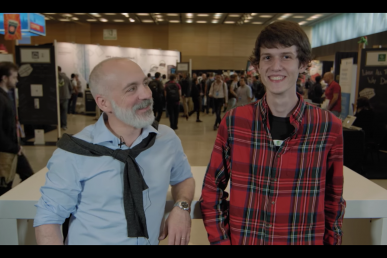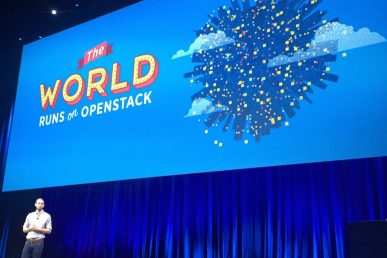BOSTON — Back by popular demand, the Interoperability Challenge again took the stage in one of the most exciting demonstrations to date. Brad Topol and Tong Li from IBM worked to organize the group and build the application stack, which was deployed unmodified across the 15 clouds.
15 global IT leaders raced to deploy the CockroachDB cloud-native application on Kubernetes on top of OpenStack. The challenge successfully demonstrated that containers can run smoothly on and across multiple OpenStack clouds and distributed enterprise database systems can be deployed automatically using open source tools such as Ansible and OpenStack Shade. All 15 participants successfully deployed the cloud-native application, including Open Telekom Cloud and Vexxhost running directly on their public clouds in production. Catch the video to see the excitement!
Mark Collier, COO at the OpenStack Foundation, moved among the challengers asking questions and “sharing the dreams” of contestants. After deployment, the databases were connected together to show federation of a single, cloud native database across clouds.
In prior keynotes from Alex Polvi, CEO of CoreOS and board director for both the Cloud Native Computing Foundation and Open Container Initiative, and Spencer Kimball, CEO of Cockroach Labs, the Kubernetes and CockroachDB workload was described and run on a single OpenStack cloud. Then, the long table of participating clouds was wheeled out and introduced by Brad Topol, IBM distinguished engineer in the IBM cloud architecture and technology organization, and senior software engineer Tong Li.
The Interop Challenges in Boston and Barcelona demonstrated real-life interoperability with all participants running the same workloads and automated deployment tools across their OpenStack distributions, private, hosted private and public clouds. Not only does the Interop Challenge Working Group put on great shows; they also flush out portability issues in oft-deployed OpenStack workloads.
Interop challenge to run the same code on different clouds. #OpenStackSummit @OpenStack pic.twitter.com/05ytICD0Fm
— John Fruehe (@JohnFruehe) May 9, 2017
The Interop Challenges are organized by the Interop Working Group, formed in 2013 at the direction of the board of directors. The group also defines “what is OpenStack” and provides API and code testing for the OpenStack Powered trademark licensing program. The working group will present both sides of the interop coin in Wednesday’s community session.
In a related session following the Tuesday keynote, the Interop Challenge team will demonstrate an NFV vIMS (virtual IP Multimedia Services) workload across the clouds, using Linux Foundation collaborative project ONAP (Open Networking Automation Platform), the vIMS Clearwater project as the VNF, and Juju. OPNFV contributors assisted by providing the vIMS+ONAP+Juju scenario from the Functest system functionality testing project. The collaborators from both projects will detail how they worked together on this workload in a session following the keynotes.
Demonstrating today’s container and NFV workloads across so many OpenStack clouds, proves interoperability is a reality. Users and the ecosystem alike benefit from the ability to run workloads where best fit based on geographic, financial and regulatory factors.
- Demystifying Confidential Containers with a Live Kata Containers Demo - July 13, 2023
- OpenInfra Summit Vancouver Recap: 50 things You Need to Know - June 16, 2023
- Congratulations to the 2023 Superuser Awards Winner: Bloomberg - June 13, 2023

)










